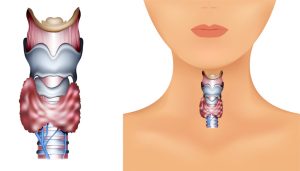
Without a normally functioning thyroid gland, humans are faced with various negative consequences due to the body’s hindered ability to break down protein and process carbohydrates.
Whether weight gain, malnutrition, or other disease exacerbation, thyroid dysfunction in some capacity is experienced by over 10% of the US population, according to the ATA (American Thyroid Association).
It’s important to take care of your thyroid gland and be aware of any problems early on. This starts with learning about its structure and how it affects your body.
In what follows, we’ll be discussing the anatomy of the thyroid gland and its cellular function. More specifically, we’ll define what the thyroid gland is, what hormones it produces, and the roles that it plays in human health, function, and optimization.
The Thyroid Gland and Its Anatomy
The thyroid gland is a small butterfly-shaped organ located at the base of the neck, just below the Adam’s apple; this is otherwise referred to as the laryngeal thyroid cartilage. This gland is a part of the endocrine system and is responsible for producing hormones that regulate the body’s metabolism and energy levels.

Made up of two lobes on either side of the trachea, the thyroid gland is connected by a narrow band of tissue called the isthmus. Each lobe is about the size of a large almond and is surrounded by a capsule of connective tissue. In some individuals, the gland is able to be palpated, but in many individuals, it is hardly noticeable.
As a gland involved in the endocrine system, the thyroid gland is supplied with blood vessels, nerves, and lymphatic vessels. The thyroid has a rich vascular supply which assists in the efficient release of thyroid hormones into the bloodstream. Inside the gland, there are tiny follicles that produce and store the hormones that affect metabolism. These follicles are lined with a single layer of cells called follicular cells, which are responsible for producing and secreting thyroid hormones.
Cellular Function of the Thyroid Gland
Though the thyroid is involved in several roles, the primary cellular function of the thyroid gland is to produce and secrete hormones that are responsible for regulating the body’s metabolism and energy levels.
The thyroid gland produces two main hormones: triiodothyronine (T3) and thyroxine (T4), which are secreted into the bloodstream. Other hormones produced and secreted by the thyroid gland include reverse triiodothyronine (RT3) and calcitonin. Calcitonin reverses the effects of T3 and regulates calcium levels, respectively.
These hormones are iodine-containing compounds that are synthesized and secreted by the thyroid gland’s follicular cells. T3 is the more active of the two hormones, while T4 is considered the pro-hormone, which means that it is converted into T3 in other parts of the body.
The production of these hormones is regulated by the hypothalamus and pituitary gland in the lower aspect of the brain, working in a synergistic, positive feedback loop system so as to optimize metabolism and energy production.
How The Feedback System Works:
- The hypothalamus produces thyrotropin-releasing hormone (TRH), which stimulates the pituitary gland to produce thyroid-stimulating hormone (TSH).
- TSH then travels through the bloodstream to the thyroid gland, where it stimulates the production and release of T3 and T4.
- Depending on whether or not the body needs more or less of these thyroid hormones, a normally functioning thyroid gland will produce optimal amounts on an as-needed basis.
- The amounts of particular hormones that are secreted are largely controlled by the brain (i.e., the hypothalamus and the pituitary gland).
This feedback loop ensures that the body has the correct amount of thyroid hormones at all times, thus optimizing the body’s metabolic function and energy production throughout. As long as this feedback system is functioning properly, the body’s homeostasis remains normal.
In addition, T3 and T4 play a role in the rate at which the body burns calories, as well as in the growth and development of the body and the functioning of the heart and nervous system.

An imbalance in the production of these hormones can lead to various health issues, such as hypothyroidism, hyperthyroidism, and Grave’s disease. Cancers of the thyroid, such as papillary thyroid carcinoma, as well as inflammatory thyroid disorders, can be a primary reason for abnormalities of thyroid hormone production.
Final Thoughts
The thyroid gland is a small but essential organ that plays a vital role in regulating the body’s metabolism and energy levels. It’s important to be familiar with the anatomy and cellular function of the thyroid, as well as the hormones produced by the thyroid gland. It’s also useful to know about the brain’s role in the feedback mechanism of thyroid hormone production.
A distortion in thyroid hormone synthesis can lead to a range of health issues, and it’s important to understand that hormone production and regulation is a complex mechanism involving the brain, thyroid, and end organs.
